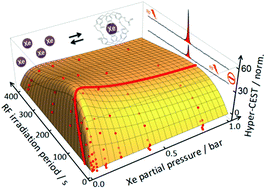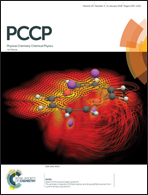Quantitative biosensor detection by chemically exchanging hyperpolarized 129Xe†
Abstract
Chemical sensors informing about their local environment are of widespread use for chemical analysis. A thorough understanding of the sensor signaling is fundamental to data analysis and interpretation, and a requirement for technological applications. Here, sensors explored for the recognition and display of biomolecular and cellular markers by magnetic resonance and composed of host molecules for xenon atoms are considered. These host–guest systems are analytically powerful and also function as contrast agents in imaging applications. Using nuclear spin hyperpolarization of 129Xe and chemical exchange saturation transfer the detection sensitivity is orders of magnitude enhanced in comparison to conventional 1H NMR. The sensor signaling reflects this rather complex genesis, furthering the mere qualitative interpretation of biosensing data; to harvest the potential of the approach, however, a detailed numerical account is desired. To this end, we introduce a comprehensive expression that maps the sensor detection quantitatively by integration of the hyperpolarization generation and relaxation with the host–xenon exchange dynamics. As demonstrated for the host molecule and well-established biosensor cryptophane-A, this model reveals a distinguished maximum in sensor signaling and exerts control over experimentation by dedicated adjustments of both the amount of xenon and the duration of the saturation transfer applied in a measurement, for example to capitalize on investigations at the detection limit. Furthermore, usage of the model for data analysis makes the quantification of the sensor concentration in the nanomolar range possible. The approach is readily applicable in investigations using cryptophane-A and is straightaway adaptable to other sensor designs for extension of the field of xenon based biosensing.



 Please wait while we load your content...
Please wait while we load your content...